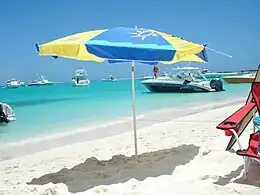Native name: Isla La Tortuga | |
|---|---|
 A beach on La Tortuga island | |
| Geography | |
| Location | Caribbean Sea |
| Coordinates | 10°55′54″N 65°18′29″W / 10.93167°N 65.30806°W |
| Major islands | 1 |
| Area | 156.60 km2 (60.46 sq mi) |
| Highest elevation | 45 m (148 ft) |
| Highest point | Altos de Garambeo |
| Administration | |
| Federal dependencies of Venezuela | |
La Tortuga Island (Spanish: Isla La Tortuga; "La Tortuga" means "the turtle") is an uninhabited island of Venezuela, the largest in the Federal Dependencies of Venezuela. It is part of a group of islands that include the Tortuguillos and Cayo Herradura. Isla La Tortuga has an area of 156 km2 (60 sq mi).[1][2][3][4]
History
The island was visited by Amerindians from the coast of present-day Venezuela to exploit its natural resources including salt, fish and turtles, well before Spanish colonization of the New World. It is not known by which European explorer the island was first seen and named, yet the name derives from the large numbers of marine turtles that come to lay eggs on its long sandy beaches every year.[5]

The island was seasonally visited by the Dutch who came there to exploit the salt evaporation ponds on the east of the island between 1624 and 1638. They constructed a fort on the island to guard their salt works and repel the Spanish who were eager to keep the Dutch off the island. They were definitively expelled in 1638 when the Spanish governor of Cumaná, Benito Arias Montano, and his forces destroyed their facilities and flooded the salt pans.[6]
Since then, with the exception of fishermen who visit the island seasonally, the island has remained unpopulated and largely untouched. There is some tourism on the island.
Gallery
See also
References
- ↑ "Dependencias Federales: Guía de Viajes Y Turismo de las Dependencia Federales - Archipiélago de Los Roques" [Federal agencies Guide Travel And Tourism Federal Unit - Los Roques Archipelago]. guiaviajesvirtual.com (in Spanish). Retrieved 15 September 2015.
- ↑ Vila, Marco Aurelio. 1967: Aspectos geográficos de las Dependencias Federales. Corporación Venezolana de Fomento. Caracas. 115p.
- ↑ Cervigon, Fernando. 1995: Las Dependencias Federales. Academia Nacional de la Historia. Caracas. 193p.
- ↑ Hernández Caballero, Serafín (Editor). 1998: Gran Enciclopedia de Venezuela. Editorial Globe, C.A. Caracas. 10 volumes. ISBN 980-6427-00-9 ISBN 980-6427-10-6
- ↑ Antczak, Maria Magdalena and Andrzej Antczak. 2006: Los Ídolos de las Islas Prometidas, Arqueología Prehispánica del Archipiélago de Los Roques. Editorial Equinoccio, Caracas. 630 p.
- ↑ Antczak, Andrzej; Antczak, Konrad A.; Antczak, Ma Magdalena (2015-05-04). "Risky business: historical archaeology of the Dutch salt enterprise on La Tortuga Island, Venezuela (1624–38)". Post-Medieval Archaeology. 49 (2): 189–219. doi:10.1080/00794236.2015.1124193. hdl:10230/53024. ISSN 0079-4236.
.jpg.webp)
.jpg.webp)
.jpg.webp)

